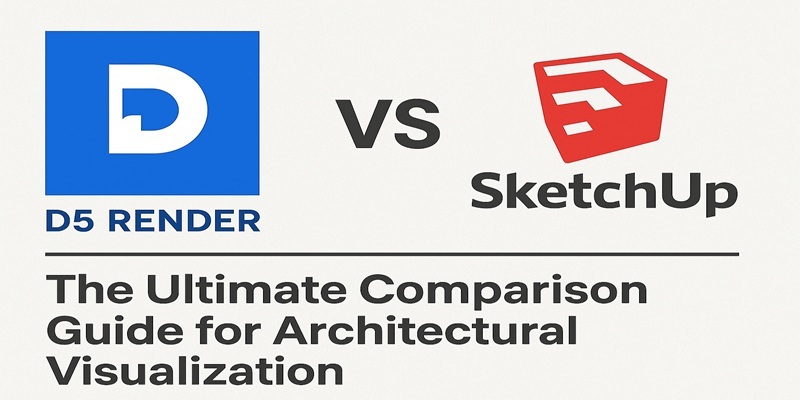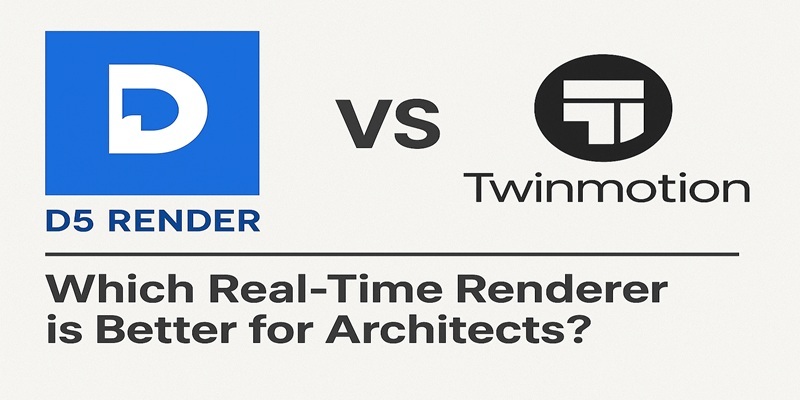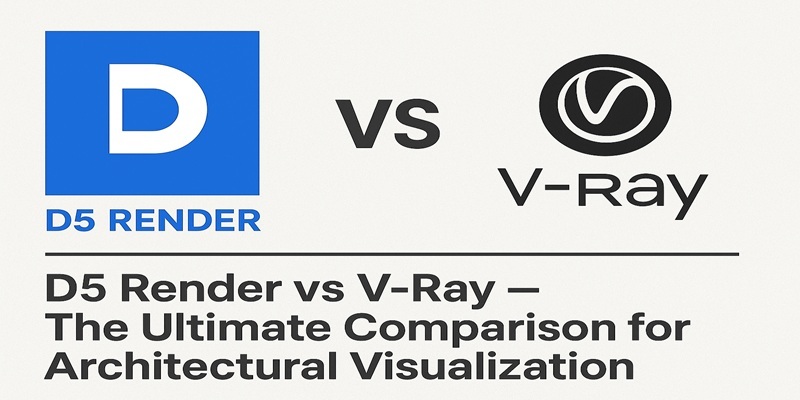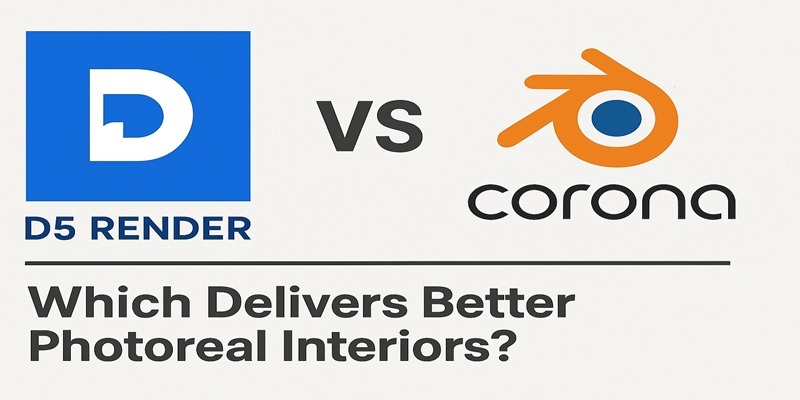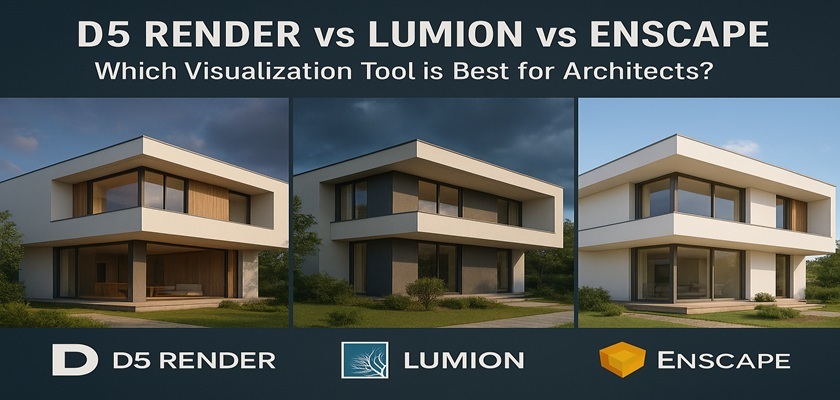
In architecture, visualization transforms ideas into images that clients can instantly connect with. It turns lines and models into spaces that feel alive. Choosing between D5 Render vs Lumion vs Enscape depends on how each tool fits your design goals and workflow. In a 2023 survey, more than 75% of architecture professionals said they use real-time rendering at least weekly.
This growth shows how essential rendering tools have become in modern practice. This article explains what each tool does, compares them across speed, realism, learning curve, and hardware needs, and helps you decide which suits your studio best.
What is D5 Render, Lumion and Enscape?
Architectural visualization tools vary in function and learning style. Understanding how D5 Render, Lumion, and Enscape differ helps you choose the one that supports your everyday workflow.
D5 Render

D5 Render is a real-time rendering tool built for architects and designers who want cinematic-quality visuals without long render times. It works seamlessly with software such as Revit, SketchUp, and Rhino. Its smooth integration with Rhino allows real-time updates, making D5 Render for Rhino a practical choice for fast iteration and presentation.
The platform’s strength lies in its vast library of d5 render models, realistic lighting, and weather controls that make d5 render architecture presentations feel detailed and alive. It also supports d5 render animation, enabling architects to produce smooth walkthroughs and flythroughs that bring their designs to life. D5 balances creative freedom with user-friendly design, making it ideal for architects who want high visual fidelity but prefer an easy learning curve.
Lumion

Lumion is known for its speed, rich scene creation, and user accessibility. Architects use it to build complete environments with trees, water, skies, and people. It comes with the Revit plugin for Lumion, allowing designers to import models directly from Revit, adjust scenes instantly, and preview updates through Lumion renders in real time.
The software’s real strength is atmosphere. Whether you’re presenting a new residential design or a large landscape project, Lumion helps express emotion through lighting, movement, and realistic textures. The tool has a gentle learning curve, making it suitable even for students or beginners experimenting with professional visualization for the first time.
Enscape

Enscape is a rendering plugin that integrates directly into modeling tools such as Revit, Rhino, and SketchUp. If you’ve ever wondered what is Enscape, it’s a real-time visualization plugin that provides instant, realistic feedback as your designs take shape. This capability makes Enscape rendering one of the fastest options available, supporting collaboration and allowing architects and clients to review ideas interactively.
Its direct link with Enscape for Revit keeps users within their modeling environment while viewing photorealistic previews in real time. Enscape 3D produces lifelike materials and reflections without needing a deep technical setup. Many firms also combine Enscape with parametric workflows to improve design testing and flexibility. D5 Render stands out for cinematic visuals, Lumion for immersive settings, and Enscape for real-time efficiency.
D5 Render vs Lumion vs Enscape: The Complete Comparison

Choosing between D5 Render vs Lumion vs Enscape comes down to performance across four main aspects: Speed, Realism, Learning Curve, and Hardware Requirements. Each criterion reveals how these tools fit different needs in architectural visualization.
1. Speed
Speed is vital for design iteration and client communication. The faster a tool responds, the easier it becomes to refine ideas.
- D5 Render: D5 runs on a real-time ray tracing engine, producing fast, smooth visuals. Architects can preview material changes instantly or create short d5 render animation clips without long render times.
- Lumion: Lumion’s LiveSync feature, supported by the Revit plugin for Lumion, ensures models update instantly between both platforms. It performs well for medium to large scenes, though very complex environments can slow it down.
- Enscape: Operating as a plugin, Enscape provides instant results within Revit or Rhino. When using Enscape for Revit, lighting and shadows refresh instantly, giving architects real-time visual feedback as they design.
In practice, Enscape is fastest for immediate design feedback, D5 excels in the balance between speed and cinematic quality, and Lumion performs well in larger outdoor scenes.
2. Realism
Realism defines how authentic and convincing the final visuals appear, encompassing elements such as lighting, texture precision, and environmental context.
- D5 Render: D5’s engine delivers lifelike lighting and reflections. The availability of detailed D5 render models enhances composition and mood, especially for interior and d5 render architecture visualizations.
- Lumion: Known for its rich environment tools, Lumion renders deliver vibrant, atmospheric visuals that capture realistic lighting and texture detail.
- Enscape: Enscape rendering focuses on balanced realism with efficiency. It produces high-quality results without slowing workflow, making it ideal for concept presentations.
D5 leads when aiming for photoreal results, Lumion for storytelling through scenery, and Enscape for practicality in real-time visualization.
3. Learning Curve
Adoption speed matters when integrating new software into your studio process.
- D5 Render: The interface is intuitive. Tutorials, templates, and smart tooltips shorten learning time, allowing teams to create strong visuals quickly.
- Lumion: Its interface is clean and accessible. Many professionals who explore revit and Lumion workflows find the transition easy and efficient. Advanced rendering features may take longer to master, but results come fast.
- Enscape: It has the simplest workflow. Once installed, Enscape 3D opens directly inside Revit or SketchUp, allowing users to start rendering immediately.
Beginners usually find Enscape easiest, D5 a balanced choice, and Lumion the most flexible for artistic growth.
4. Hardware Requirements
Hardware directly impacts rendering stability and performance.
- D5 Render: It requires a strong GPU to handle render animation and ray tracing efficiently. Systems with at least 8GB VRAM perform best.
- Lumion: It is GPU-intensive, especially with high-quality Lumion renders or complex vegetation scenes. However, the software scales performance depending on available hardware.
- Enscape: More hardware-friendly than the others. Enscape for Revit runs smoothly even on mid-range GPUs, though larger Enscape rendering projects still require adequate VRAM.
If your studio has high-end systems, D5 and Lumion will perform beautifully. If you work on lighter setups, Enscape remains dependable for day-to-day visualization.
When comparing Lumion vs Enscape alongside D5 Render, each tool contributes differently to architectural visualization. D5 Render is strong for detailed, cinematic work. Lumion excels in full-context scenes with rich outdoor elements. Many architects adopt multi-tool workflows: making quick design moves in Enscape, then refining in D5 or Lumion for client presentation. Use these comparisons to choose options aligned with your process, project types, and hardware resources.
Conclusion
Architectural visualization has become central to design communication, bridging imagination and construction. Comparing D5 Render vs Lumion vs Enscape shows how each tool serves unique goals. D5 Render stands out for its realism and polished animations, Lumion excels in crafting environments filled with light and movement, and Enscape leads in simplicity and speed.
Choosing the best depends on your project type, hardware, and how your team works. To master visualization workflows, building strong foundations in computational design is essential. The Master Computational Design Course offered by Novatr helps you gain the digital and design fluency needed to create technically advanced architecture projects.
Visit our resource page to explore more learning paths that can help you grow your architectural skillset.
Was this content helpful to you



.jpg)
